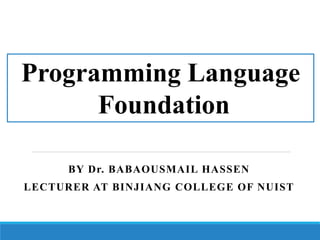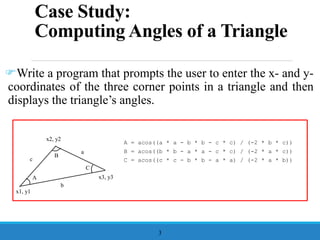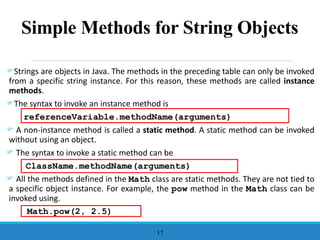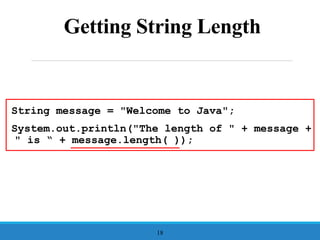Java Object Orientend Programming 1.pptx
- 1. Programming Language Foundation BY Dr. BABAOUSMAIL HASSEN LECTURER AT BINJIANG COLLEGE OF NUIST
- 2. Chapter 4 Mathematical Functions, Characters, and Strings Continue…
- 3. Case Study: Computing Angles of a Triangle Write a program that prompts the user to enter the x- and y- coordinates of the three corner points in a triangle and then displays the triangle’s angles. 3 A B C a b c A = acos((a * a - b * b - c * c) / (-2 * b * c)) B = acos((b * b - a * a - c * c) / (-2 * a * c)) C = acos((c * c - b * b - a * a) / (-2 * a * b)) x1, y1 x2, y2 x3, y3
- 4. Character Data Type In addition to processing numeric values, you can process characters in Java. The character data type, char, is used to represent a single character. A character literal is enclosed in single quotation marks. Consider the following code: char letter = 'A'; char numChar = '4'; ◦ The first statement assigns character A to the char variable letter. ◦ The second assigns digit character 4 to the char variable numChar. 4
- 5. Character Data Type, Computers use binary numbers internally. A character is stored in a computer as a sequence of 0s and 1s. Mapping a character to its binary representation is called encoding. There are different ways to encode a character. ◦ Unicode ◦ ASCII code Java supports Unicode, which was originally designed as a 16-bit character encoding. A 16-bit Unicode takes two bytes, preceded by u, expressed in four hexadecimal digits that run from u0000 to uFFFF. Most computers use ASCII (American Standard Code for Information Interchange), an 8-bit encoding. Unicode includes ASCII code, with u0000 to u007F corresponding to the 128 ASCII characters. 5
- 6. Character Data Type, NOTE: The increment and decrement operators can also be used on char variables to get the next or preceding Unicode character. For example, the following statements display character b. ◦ char ch = 'a‘; ◦ System.out.println(++ch); 6 char letter = 'A'; (ASCII) char numChar = '4'; (ASCII) char letter = 'u0041'; (Unicode) char numChar = 'u0034'; (Unicode) Four hexadecimal digits.
- 7. Unicode Format Unicode takes two bytes, preceded by u, expressed in four hexadecimal numbers that run from 'u0000' to 'uFFFF'. Unicode can represent 65534 characters. 7 Unicode u03b1 u03b2 u03b3 for three Greek letters
- 8. ASCII Character Set, ASCII Character Set is a subset of the Unicode from u0000 to u007F 8
- 9. ASCII Code for Commonly Used Characters 9 Characters Code Value in Decimal Unicode Value '0' to '9' 48 to 57 u0030 to u0039 'A' to 'Z' 65 to 90 u0041 to u005A 'a' to 'z' 97 to 122 u0061 to u007A
- 10. Escape Sequences for Special Characters 10
- 11. A char can be cast into any numeric type, and vice versa. ◦ When an integer is cast into a char, only its lower 16 bits of data are used; the other part is ignored. ◦ When a floating-point value is cast into a char, the floating-point value is first cast into an int, which is then cast into a char. ◦ When a char is cast into a numeric type, the character’s Unicode is cast into the specified numeric type. 11 Casting between char and Numeric Types
- 12. Casting between char and Numeric Types, cont. Implicit casting can be used if the result of a casting fits into the target variable. Otherwise, explicit casting must be used. For example, 12 √ √ × √
- 13. Comparing and Testing Characters Two characters can be compared using the relational operators just like comparing two numbers. This is done by comparing the Unicodes of the two characters. For example, if (ch >= 'A'&& ch <= 'Z') System.out.println(ch + " is an uppercase letter"); else if (ch >= 'a' && ch <= 'z') System.out.println(ch + " is a lowercase letter"); else if (ch >= '0' && ch <= '9') System.out.println(ch + " is a numeric character"); 13
- 14. Methods in the Character Class For convenience, Java provides the following methods in the Character class for testing characters. 14 Method Description isDigit(ch) Returns true if the specified character is a digit. isLetter(ch) Returns true if the specified character is a letter. isLetterOfDigit(ch) Returns true if the specified character is a letter or digit. isLowerCase(ch) Returns true if the specified character is a lowercase letter. isUpperCase(ch) Returns true if the specified character is an uppercase letter. toLowerCase(ch) Returns the lowercase of the specified character. toUpperCase(ch) Returns the uppercase of the specified character.
- 15. The String Type The char type only represents one character. To represent a string of characters, use the data type called String. For example, String message = "Welcome to Java "; The String type is not a primitive type. It is known as a reference type. Any Java class can be used as a reference type for a variable. Reference data types will be thoroughly discussed in Chapter 9. For the time being, you just need to know ◦ how to declare a String variable, ◦ how to assign a string to the variable, ◦ how to concatenate strings, ◦ to perform simple operations for strings. 15
- 16. Simple Methods for String Objects 16 Method Description Returns the number of characters in this string. Returns the character at the specified index from this string. Returns a new string that concatenates this string with string s1. Returns a new string with all letters in uppercase. Returns a new string with all letters in lowercase. Returns a new string with whitespace characters trimmed on both sides. length() charAt(index) concat(s1) toUpperCase() toLowerCase() trim()
- 17. Simple Methods for String Objects Strings are objects in Java. The methods in the preceding table can only be invoked from a specific string instance. For this reason, these methods are called instance methods. The syntax to invoke an instance method is referenceVariable.methodName(arguments) A non-instance method is called a static method. A static method can be invoked without using an object. The syntax to invoke a static method can be ClassName.methodName(arguments) All the methods defined in the Math class are static methods. They are not tied to a specific object instance. For example, the pow method in the Math class can be invoked using. Math.pow(2, 2.5) 17
- 18. Getting String Length String message = "Welcome to Java"; System.out.println("The length of " + message + " is “ + message.length( )); 18
- 19. Getting Characters from a String String message = "Welcome to Java"; System.out.println("The first character in message is “ + message.charAt(0)); 19


















